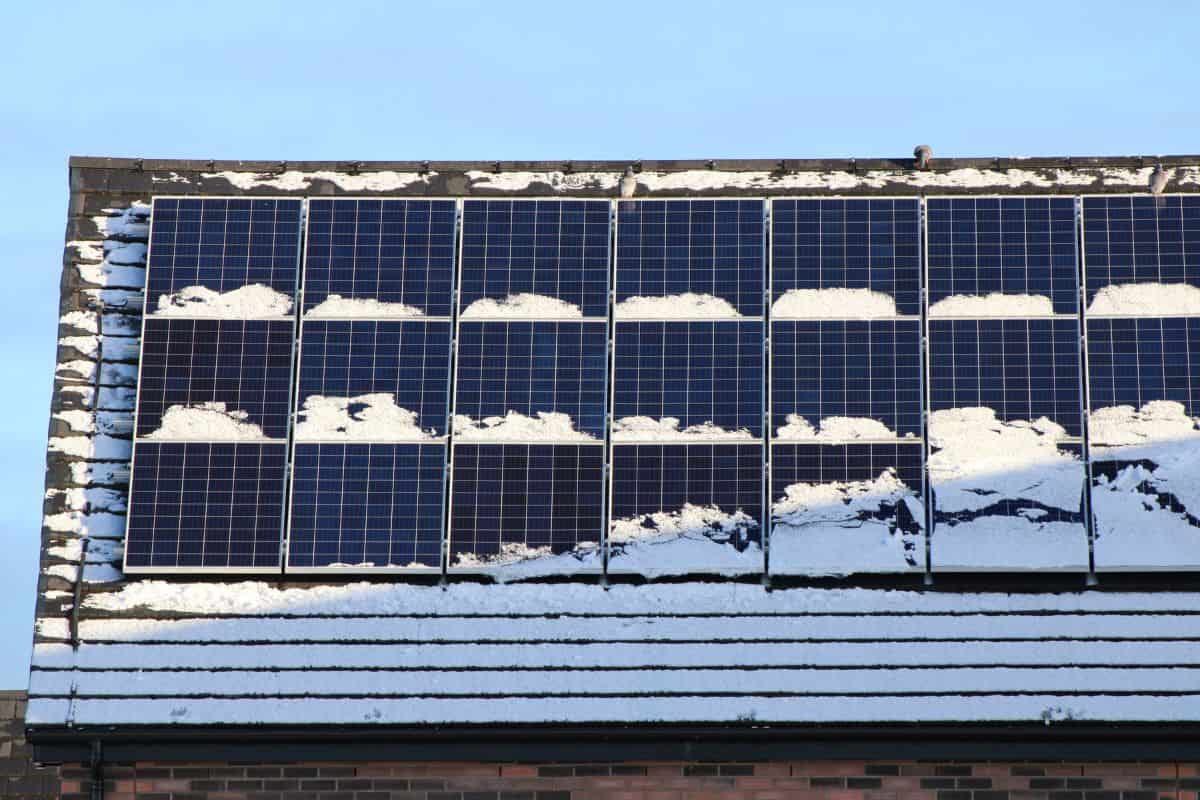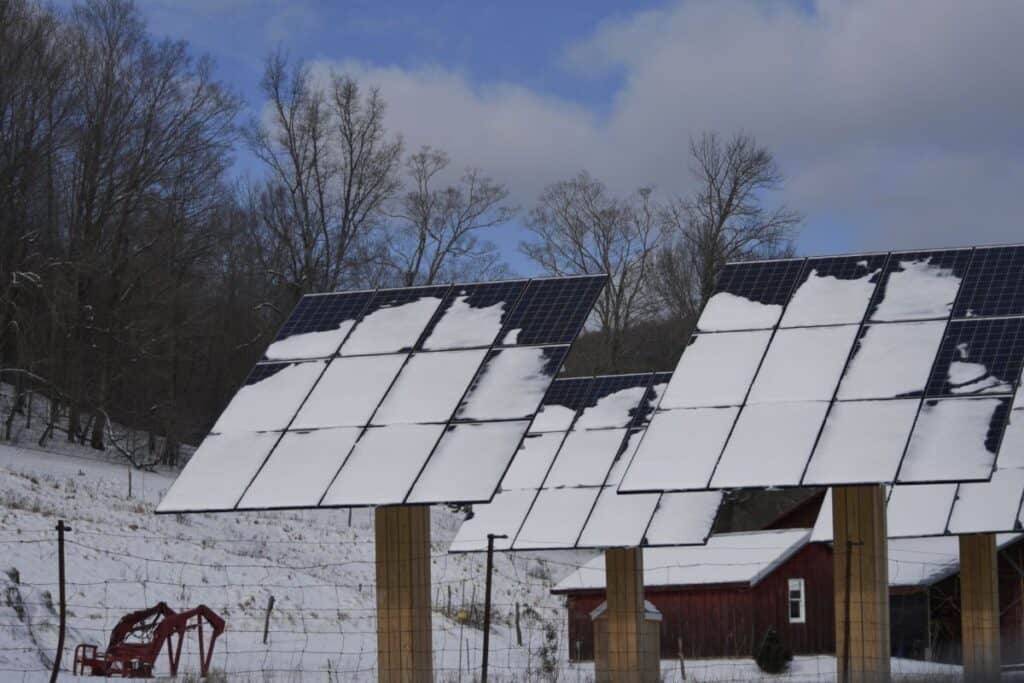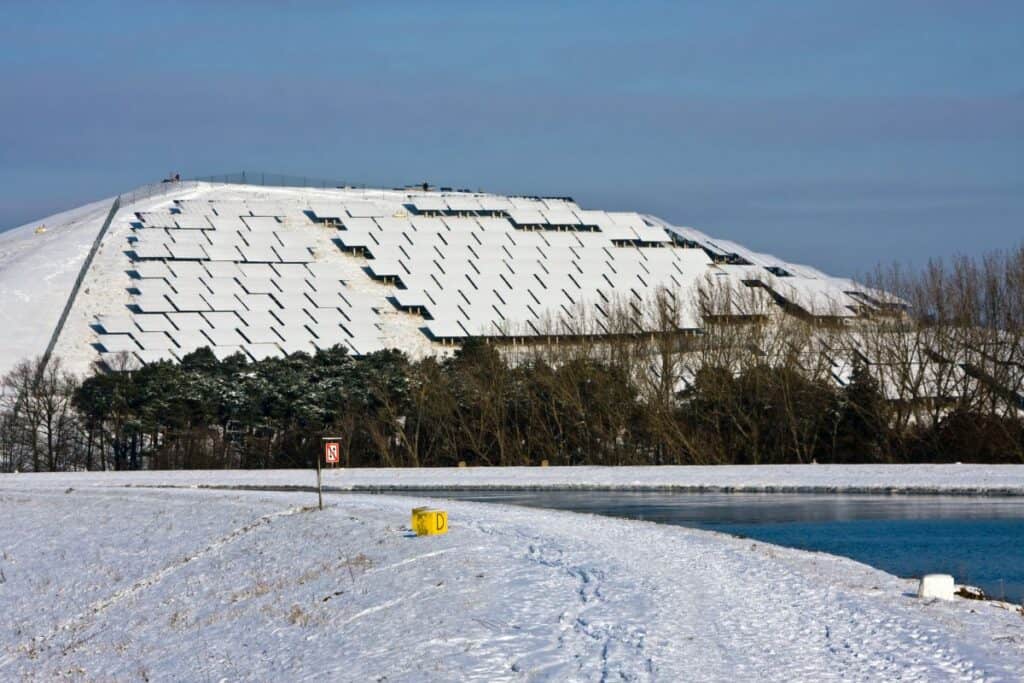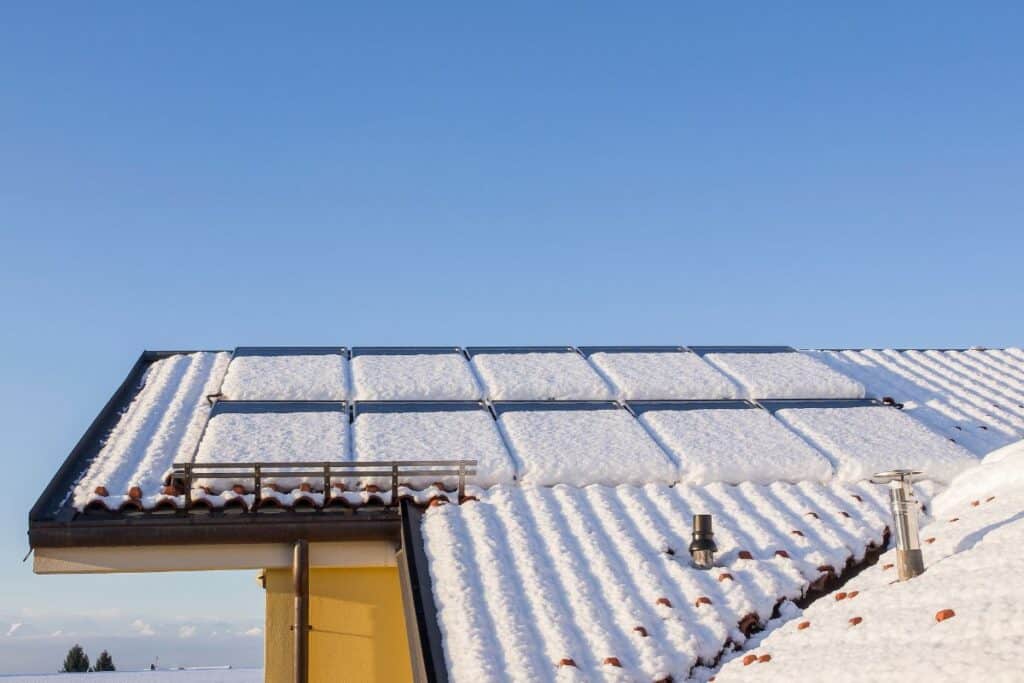So, you’re considering installing solar panels, but you’re worried about those snowy winters?
Let’s dive into the nitty-gritty of how snow affects solar panels.
You’ll be surprised to know that snow can actually enhance the performance of solar panels in certain conditions. Don’t worry, we’re here to explain it all. Snow, with its pure white surface, can act as a reflector for sunlight.
This phenomenon, coupled with the cold weather, which is known to improve solar panel efficiency, can sometimes result in what’s known as the ‘albedo effect’.
This effect is when sunlight is reflected off the snow onto the panels, actually increasing their output.
However, this doesn’t mean that snow is always beneficial for solar panel efficiency.

When snow accumulates on the panels, it can block sunlight and reduce energy production. (You can learn more about increasing your solar power production here)
Thankfully, most solar panels are installed at an angle, causing the snow to slide off more easily. This combined with the fact that the underside of a layer of snow tends to melt when exposed to sunlight, typically results in the panels being clear of snow most of the time.
It’s important to note that trying to manually remove snow from your solar panels can lead to potential damage.
Using tools or even just brushing the snow off can scratch the surface, leading to a reduction in their performance.
So, it’s usually best to let nature take its course and allow the snow to melt naturally.
Now, you might be wondering about those dreary, cloudy winter days. Yes, solar panels do produce less energy in the absence of direct sunlight. But they don’t stop working entirely. They can still generate power from diffused sunlight (the light that scatters through the clouds), although it’s less than on a sunny day.
If you live in an area with heavy snowfall and frequent cloudy days, one solution to maintain a steady power supply during winter could be to install more panels.
Having a larger system would compensate for the lower individual panel efficiency in the winter.
Another thing to consider is that energy production of solar panels is calculated on an annual basis, taking into account the changes in seasons.
Solar panels typically produce more energy in the sunny summer months, making up for any shortfall during the winter. So, in many cases, the effect of snow is already considered in your solar system’s design and projected output.
While snow can impact solar panel efficiency, it’s rarely a deal-breaker.
The design of solar panels, the possibility of enhanced reflectivity, and the compensation through annual energy calculations all work together to ensure that your solar system is a worthwhile investment – snow or shine!

Should You Remove Snow from Solar Panels: To Brush or Not to Brush?
Is there a thick blanket of snow on your solar panels and you’re considering cleaning it off? Before you grab your broom, let’s examine if this action is really necessary.
The short answer is usually, no – it’s best to leave the snow removal to mother nature. Solar panels are designed to withstand various weather conditions, including snow, and typically, they will warm up enough to melt the snow away by themselves.
Now, why would you want to avoid manually cleaning off the snow?
Firstly, the risk of damaging your solar panels is significantly high. Even a minor scratch on the panel’s surface can impede its performance.
Using any tool, even a soft brush, to remove snow could potentially lead to such damage.
Secondly, remember that most solar panels are installed on rooftops, making the process of cleaning them not only challenging but also potentially dangerous in snowy and icy conditions.
Falling from a roof is a serious hazard, and it’s not worth the risk to increase a solar panel’s productivity slightly.
However, suppose you’re worried about a long snowstorm or exceptionally heavy snowfall. In that case, you might consider a couple of safe alternatives for snow removal.

One is to install a solar panel snow rake with a soft rubber squeegee. These are designed to remove snow from solar panels without damaging them.
But, caution is still required when using these devices, and they should be used from the ground, not while standing on a ladder or the roof.
Another option is to install solar panel heating systems.
Can You Get Heated Solar Panels for Snow?
Maybe you live in an area where heavy snowfall is the norm, let’s warm up to this topic and find out if you get heated solar panels.
The answer is yes, heated solar panels are indeed a thing and they can be a great solution for regions that receive substantial amounts of snowfall. These panels are designed with integrated heating elements that help melt the snow faster, ensuring that your solar system maintains its productivity even during the coldest months.
Heated solar panels are made by placing thin electrical heating elements within the panel.
When activated, these elements produce heat that can help melt any accumulated snow or ice. The heat spreads evenly across the surface, making sure every square inch is effectively cleared.
That being said, the use of heated solar panels is not a widespread practice.
One of the reasons is that the energy required to heat the panels often outweighs the energy losses caused by snow accumulation.
In other words, the electricity you’d use to melt the snow could be more than the electricity you’d lose due to the snow cover. This makes heated solar panels less cost-effective compared to their non-heated counterparts.
Another factor to consider is the initial cost of heated solar panels, which can be higher than regular panels. This, combined with their increased operational cost, could make the overall return on investment (ROI) less attractive.
Finally, remember that regular solar panels are designed to be self-clearing when it comes to snow. (For general cleaning this DIY Solar Cleaning guide may help)
Given their dark color, smooth surface, and optimal tilt, they naturally absorb sunlight, generate heat, and, over time, melt and slide off the snow. Most homeowners find that this natural process is sufficient, and heated panels aren’t necessary.
The loss of energy production due to snow is usually factored into the calculation when determining the expected energy output of your solar system over a year. This accounts for the seasonal variation in weather.
In conclusion, while it might be tempting to try and maximize your solar panel efficiency by removing the snow, it’s usually best to let it melt naturally.
In doing so, you avoid the potential risks of personal injury and damaging your panels, while still enjoying a steady, reliable energy source year-round.
Let’s now look at whether or not solar panels melt snow faster than normal…
Do Solar Panels Melt Snow?
You’ve just woken up to a beautiful winter morning and your solar panels are covered in snow. You’re probably wondering, will the snow melt by itself?
Yes, solar panels often have a self-cleaning mechanism in terms of snow. When properly installed at an optimal angle, solar panels are designed to efficiently absorb the sun’s rays and convert it into electricity. This process creates heat which, in turn, helps melt the snow that’s accumulated on the panel surface.
Solar panels have a smooth surface, usually angled towards the sun, so when the heat generated from the panels starts to melt the snow, it typically slides off.

Also, given that solar panels are dark in color, they naturally absorb more sunlight and heat, further aiding in the snow melting process.
However, the efficiency of this process greatly depends on the thickness of the snow, the ambient temperature, and the amount of sunlight the panels are receiving.
But, what if the snow is particularly heavy, or the weather is extremely cold? In these cases, the snow might take longer to melt, and the energy production could be affected.
But don’t worry, this effect is usually temporary and production will return to normal levels as soon as the snow clears. Furthermore, the calculations made when installing your solar system take these weather patterns and potential production decreases into account.
However, if you live in an area with heavy and frequent snowfall, there are options to enhance the self-cleaning process.
As mentioned earlier, solar panel snow rakes and heating systems can be used. But, it’s important to reiterate that manual cleaning is risky, and these measures are generally only necessary in areas with significant snowfall.
If you live in one of those areas, you may now be wondering if you need to take additional steps to protect your solar panels…
How to Protect Solar Panels When It Snows?
Winter weather brings its challenges, but does it have to mean the downfall of your solar panels? Not at all. Let’s delve into ways to protect your solar panels during a snowy season.
In reality, solar panels are designed to withstand various weather conditions, including snow. Manufacturers understand that their products must endure all sorts of climates, and hence, solar panels are typically built with durable materials like tempered glass to resist the weight of snowfall.
One of the most basic yet effective steps to protect solar panels in snow is proper installation.
Solar panels should be installed at an angle, ideally equivalent to your latitude, which helps the snow slide off more easily. In addition to encouraging self-clearing, this also maximizes sunlight exposure throughout the year.
For heavier snowfall, you might consider a snow rake specifically designed for solar panels.
These rakes have soft bristles and a long, telescopic handle, allowing you to gently brush off snow without damaging the panels. However, safety first! If your panels are on a high roof, it’s best to leave snow removal to professionals to avoid any risk of injury.
Another way to safeguard your solar panels is by applying a hydrophobic coating. These coatings make the surface of your panels water-resistant, which can help the snow to slide off the panels more easily.
Monitoring is another essential part of protecting your solar panels in snowy weather. Keeping a close eye on your energy output during the winter can help you quickly identify any significant dips that might be caused by snow coverage.
Last but not least, make sure your solar panel system is regularly maintained.
Routine check-ups and professional cleanings can ensure your panels are in their best shape to handle snow and continue operating efficiently.
Now that we’ve dealt with snow, what about Ice?
Ice Encounters: Dealing with Ice on Solar Panels
Let’s dive into the impact of ice on solar panels and how you can combat it.
Just like snow, ice can potentially affect the performance of your solar panels. A thick layer of ice can prevent sunlight from reaching the cells, thus reducing the energy production. Moreover, in rare cases, icicles can cause physical damage if they fall onto the panels. But, don’t worry – we’ve got some practical solutions for you.
The first and foremost step to manage ice is proper installation.
As we discussed with snow, panels should be installed at an angle to allow ice and snow to slide off naturally. In regions prone to ice and snow, solar panels are often installed at a steeper tilt to encourage this sliding off.
Next, if you notice a build-up of ice on your panels, you can use a specialized solar panel snow rake to gently remove it.
Remember, be careful when doing this and consider hiring a professional if your panels are difficult to reach or if there’s a risk of causing damage.
For a more preventative approach, you could consider a hydrophobic coating for your panels. Just like with snow, this coating repels water and can help to prevent ice from sticking to your panels in the first place.
In some cases, solar panel owners in very icy climates opt for integrated heating systems. These systems can automatically warm up the panels to a temperature that facilitates the melting of the ice. However, keep in mind that these systems consume energy and can add to the cost of your setup.
Lastly, monitoring your energy output is important. If you notice a significant decrease, it might be due to ice build-up. Regular check-ups and maintenance will help ensure your panels are working optimally despite the icy conditions.
In conclusion, dealing with ice on solar panels might require a bit of effort and precaution, but it’s certainly manageable.
Correct panel placement, gentle removal methods, protective coatings, and occasional heating systems can all contribute to keeping your solar panels ice-free and efficient during the colder months.
